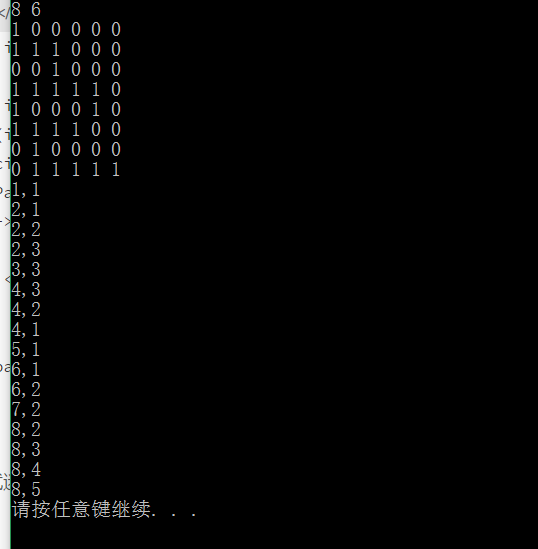最近学了堆栈,里面有个迷宫寻址的程序蛮有意思的,觉得程序的思路也很厉害。
以下代码的迷宫寻址函数是《数据结构、算法与应用 C++语言描述》上的,自己也有一点小的改动。其中关于代码的分析都在注释中了,希望能看懂。
#include<iostream>
using namespace std;
struct Position
{
friend ostream& operator<<(ostream& out, Position& x);
int row, col;
};
ostream& operator<<(ostream& out, Position& x)
{
cout << x.row << "," << x.col;
return out;
}
template<typename T>
class Stack
{
public:
Stack(int size);
~Stack() { delete[] stack; }
int Size()const { return top + 1; }
bool IsEmpty() { return top == -1; }
bool IsFull() { return top == size - 1; }
void Add(const T& x);//往stack栈顶添加元素
void Delete(T& x);//删除stack栈顶,并将删除的元素给x
void Output()const;//输出stack中的所有元素
private:
T* stack;
int size;
int top;
};
template<typename T>
Stack<T>::Stack(int size)
{
this->size = size;
stack = new T[size];
top = -1;
}
template<typename T>
void Stack<T>::Add(const T& x)
{
if (IsFull())
throw "THIS STACK IS FULL";
stack[++top] = x;
}
template<typename T>
void Stack<T>::Delete(T& x)
{
if (IsEmpty())
throw "THIS STACK IS EMPTY";
x = stack[top--];
}
template<typename T>
void Stack<T>::Output()const
{
for (int i = 0; i <=top; i++)
cout << stack[i]<<endl;
}
static Stack<Position>* path; //用来存放路径
//迷宫寻址函数
bool FindPath(int m,int n,int** maze)
{
//寻找从位置(1,1)到出口(n,n)的路径
//成功返回true,失败返回false
path = new Stack<Position>(m*n-1);
//对偏移量进行初始化
Position offset[4];
offset[0].row = 0; offset[0].col = 1;//往右走
offset[1].row = 1; offset[1].col = 0;//往下走
offset[2].row = 0; offset[2].col = -1;//往左走
offset[3].row = -1; offset[3].col = 0;//往上走
//在迷宫周围增加一圈障碍物:1表示能走,0表示不能走
for (int i = 0; i <= m + 1; i++)maze[0][i] = maze[m+1][i] = 0;//顶部和底部
for (int i = 0; i <= n + 1; i++)maze[i][0] = maze[i][n+1] = 0;//左部和右部
//输出迷宫
/*
for (int i = 0; i <= m + 1; i++)
{
for (int j = 0; j <= n + 1; j++)
cout << maze[i][j] << " ";
cout << endl;
}
*/
Position here;
here.row = here.col = 1;
maze[1][1] = 0;//设为0防止到时候回到起点
int option = 0;//选择走的方向:0往右走 1往下走 2往左走 3往上走
int maxOption=3;//能选择的最大option
while (!(here.row == m && here.col == n))//还没走到终点的时候继续寻址
{
//寻找并移动到一个相邻的位置
int row, col;
while (option <= maxOption)
{
row = here.row + offset[option].row;
col = here.col + offset[option].col;
if (maze[row][col])break;//某个方向能走时退出循环尝试寻址
option++;
}
//找到能走的相邻位置
if (option <= maxOption)
{
//这里的策略是将here作为一个候选者,先不将here放到path中去,如果here周围有能走的Position,将那个Position作为新的here,而原先的here放到path中去
path->Add(here);
here.row = row;
here.col = col;
//设置障碍继续寻址,防止新的here在寻址时将之前的here作为可走的路
maze[row][col] = 0;
option = 0;//开始在新的here附近找能走的路
}
//没有找到能走的相邻位置
else
{
if (path->IsEmpty())return false;//没有找到相邻的能走的路,同时也没有退路,就返回false
Position prePosition;//找不到能走的路就说明path栈顶的那个Position也是不能走的,所以要将原先的那个Position弹出栈
path->Delete(prePosition);
/*
下面两行代码是关键,需要好好分析一下:
因为是找path,所以path中任意两个相邻元素在迷宫maze中的位置一定也是相邻的,而path栈顶那个prePosition也一定和候选者here是相邻的
先判断之前那个Position是不是和找不到可走路的here在同一行,
如果在同一行,
(1)prePosition.col-here.col==1,即here在prePosition左侧,说明之前已经尝试过prePosition的右侧、下侧和左侧(根据之前的0右1下2左3上原则),那么接下来尝试走上侧的路;
(2)prePosition.col-here.col==-11,即here在prePosition右侧,说明之前只尝试过prePosition的右侧,那么接下来尝试走下侧的路;
如果不在同一行(那么一定在同一列),分析过程同上。 注意如果这时option变成4后,说明prePosition也是一个四周都走不通的Position,那么还得退回到prePosition的prePosition,这类似于递归又回退,但又不是递归。因此如果此时option变成4后下一次直接跳到else中进行重新寻址
*/
if (prePosition.row == here.row)option = 2 + prePosition.col - here.col;
else option = 3 + prePosition.row - here.row;
//这时候选的变成prePosition
here = prePosition;
}
}
return true;
}
int main()
{
int m,n;
int** maze;
//输入迷宫行数列数
cin >> m >> n;
//生成迷宫,加上周围的“围墙”
maze = new int*[m + 2];
for (int i = 0; i < m+2; i++)maze[i] = new int[n + 2];
//输入迷宫
for (int i = 1; i <= m; i++)
for (int j = 1; j <= n; j++)
cin >> maze[i][j];
if (FindPath(m, n, maze))
path->Output();
else
cout << "Can not find the way " << endl;
system("pause");
}下面是我的测试迷宫

























 188
188

 被折叠的 条评论
为什么被折叠?
被折叠的 条评论
为什么被折叠?








